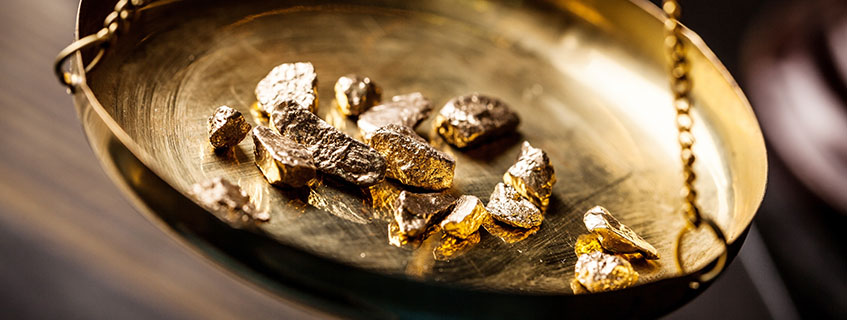
It’s renowned as a safe haven asset, charging to the rescue when the global economic order appears on the brink, as in the first months of 2020 or during the global financial crisis in 2008. Gold is especially coveted for its lack of historical correlation with equities and bonds – bracing portfolios with valuable diversification potential, especially in high inflation scenarios. But where should you go panning for your gold?
The obvious route is physical ownership. You could stash a pile of gold coins in a safe place or buy a gold ETC that stores your hoard for you. But there’s another route to the big X on our treasure map and that’s investing in gold mining companies.
Gold miner ETFs enable you to own shares in a diversified set of firms whose business is the discovery, extraction and processing of the precious yellow stuff from mines across the globe.
Because their fortunes are tied to the gold price, you gain exposure to gold as an asset class. Of course, there’s more to it than that, which is why investing in gold miners is such an interesting prospect.
The gold standard
The famed weakness of owning physical gold is that it’s an unproductive asset. It sits in bomb-proof vaults, it’s babysat by armed guards but it doesn’t pay dividends. You can count it, you can roll in it, you can wear it, but to profit from it? Then you’re relying on someone else buying it from you at a higher price in the future.But gold’s limited practical use has handcuffed its real return to the point where it’s near indistinguishable from inflation over the long-term.
Not so with gold miner ETFs. Because you’re investing in the shares of firms, you benefit from the usual sources of return expected of any company that adds economic value: the equity risk premium, earnings growth and dividends.
Good management enables miners to hammer their costs and drive profits when gold prices soar. It can also hedge prices to guard against inevitable drops in demand. A mining company can even decide to stop production when the price is low and sit on their reserves until profitability returns. This offers an option against the gold price which reduces risk.
What’s more, precious metal equities have historically delivered the most important features of gold ownership – low correlation with the broad stock market and good performance during periods of high inflation.
Volatility equals opportunity
A key reason why gold miners enjoy low correlation with the rest of the market is because they are volatile. Volatile with a capital V. The annual swings in precious metal equity returns are often wild even in comparison to the stock market.The returns of an ETF that tracks the DAXglobal® Gold Miners index over the last few years illustrate the point:
Performance of the L&G Gold Mining UCITS ETF

Source: justETF Research; as of 20/05/2020
- 2016 delivered a massive 80% gain.
- 2017 scraped a small return.
- 2018 saw a loss of 6%.
- 2019 marked a rapid return to the glory days with a 38% gain.
- After a big loss induced by the corona crisis, there was a quick and strong recovery.
Why are gold miner ETF returns so manic? As the California Gold Rush of the 19th Century reminds us, it’s because gold mining is a risky business.
Firstly, the costs of a gold mine are largely fixed. That makes mining a leveraged play on the gold price. If the price heads south by 20% but your mine is unprofitable at that price then profits fall by 100%. Leverage works in reverse too. If each nugget costs much the same to produce, then a 20% rise in the gold price can easily super-charge profits by 50%.
On top of that, some companies use debt to finance further exploration and production. Debt multiplies the leverage effect, so a company can boom when prices are high and profits easily cover their interest payments. But bust can ensue if demand drops unexpectedly, cash-flow dries up and all those fixed-cost mines prove about as useful as a cannonball around your neck in a swimming competition.
This leverage effect feeds back into the sector’s volatility as it means that basket cases can turn into ten-baggers and back as the gold price swings like a weather vane.
Fortune favours the brave
As if that wasn’t adventuring enough, there are plenty of other risks to be borne by treasure seekers.A mining company’s fortunes are tied to the value of assets buried in the ground. Of course, they don’t know precisely how large or accessible the deposits are until they’re dug up. Feasibility reports can over- or underestimate the worth of a site and trying to balance the size and grade of your gold versus the cost of extraction is always hit and miss.
Political risks abound too. Miners operating in unstable territories must contend with a list of threats ranging from corruption through unfavourable changes in legislation (think tax, tariffs, and minimum wages) all the way up to nationalisation or confiscation of assets.
The business model can also be maimed by disputes with the labour force or environmental or indigenous groups. The price of oil is a potential tripwire as well. Oil is a significant cost of mining exploration, so a price surge can further squeeze profit margins.
Physical gold ownership is a rollercoaster ride too, but it is a direct reflection of the spot price and independent of management’s ability to navigate the cross-winds of the mining business.
But it’s the very volatility of gold mining ETFs that creates the ultimate buy low, sell high opportunity – if you can stomach the risk. A small allocation of 5% or even less will do the trick, but the most important thing is to maintain your discipline even if the pay-off takes years.
Gold miner ETFs - what to watch out for
If you think you’ve got the iron discipline to maintain an allocation to a gold mining ETF, then the first question to ask is: does its index mostly track major or junior miners?Junior miners are smaller companies that live or die by exploration. Glowing feasibility reports may skyrocket their valuations while bad news can crater them. Juniors fail often but some will hit the jackpot. When they do, they act like feeder football clubs: selling the next Messi (i.e. their lucrative gold mine) to one of the big boys. They are the adventurous choice even in this high-risk sector.
Major mining companies are more stable and often have a globally diversified operation and the capital reserves to withstand shocks. When prices move against them, they can cover their costs out of capital while slowly scaling back production. They are also less liable to be shaken by the failure of any single deposit to live up to its billing. Major mining equities are at lower risk than juniors and are more likely to pay dividends.
The index name and factsheet description will often reveal whether it’s a large-cap or small-cap index but you can also compare average market caps. For example, the VanEck Vectors Gold Miners ETF has an average market cap of USD 14.9B versus 2.3B for the VanEck Vectors Junior Gold Miners ETF (as of 04/2020).
Given the riskiness of the sector, it’s comforting to know that your ETF is diversified across multiple miners. The number of holdings or constituents tells you how many firms the ETF tracks: the higher, the better. Indices can also put a cap on your exposure to individual firms (e.g. a max. of 15% of the ETF’s value) so you’re not over-concentrated in any single player.
Another factor is what percentage of firms’ revenues come from gold mines? Some firms will earn a fair chunk of their change from silver too. That may diversify your exposure to the gold price but will also dilute your returns when gold is on a tear.
To improve your exposure to the physical gold price then choose an index that follows companies that hedge their positions for short periods of time. They will do well when the gold price spikes but will struggle when the gold loses its shine.
Finally, make sure you’re comfortable with the geographic spread of your index. Most companies concentrate more than 50% on mines in Canada with the US and Australia also looming large.
If you’d like more nuggets of wisdom on this topic then check out our gold miner indices guide.
Then use the ETF Screener to pan for gold mining ETFs (use the filters "equity", "basic materials" and search for "gold") and see the list below:
| ETF name | Ticker / ISIN | Fund size (m GBP) | TER |
|---|---|---|---|
| Amundi NYSE Arca Gold Bugs UCITS ETF Dist | GLDM LU2611731824 | 343 | 0,65% p.a. |
| HANetf AuAg ESG Gold Mining UCITS ETF | ESGO IE00BNTVVR89 | 18 | 0,60% p.a. |
| iShares Gold Producers UCITS ETF | IS0E IE00B6R52036 | 1 717 | 0,55% p.a. |
| L&G Gold Mining UCITS ETF | ETLX IE00B3CNHG25 | 231 | 0,55% p.a. |
| UBS ETF (IE) Solactive Global Pure Gold Miners UCITS ETF (USD) A-dis | UBUD IE00B7KMNP07 | 258 | 0,43% p.a. |
| VanEck Gold Miners UCITS ETF | GDX IE00BQQP9F84 | 1 512 | 0,53% p.a. |
| VanEck Junior Gold Miners UCITS | GDXJ IE00BQQP9G91 | 472 | 0,55% p.a. |
Source: justETF Research; as of 08/05/2025












